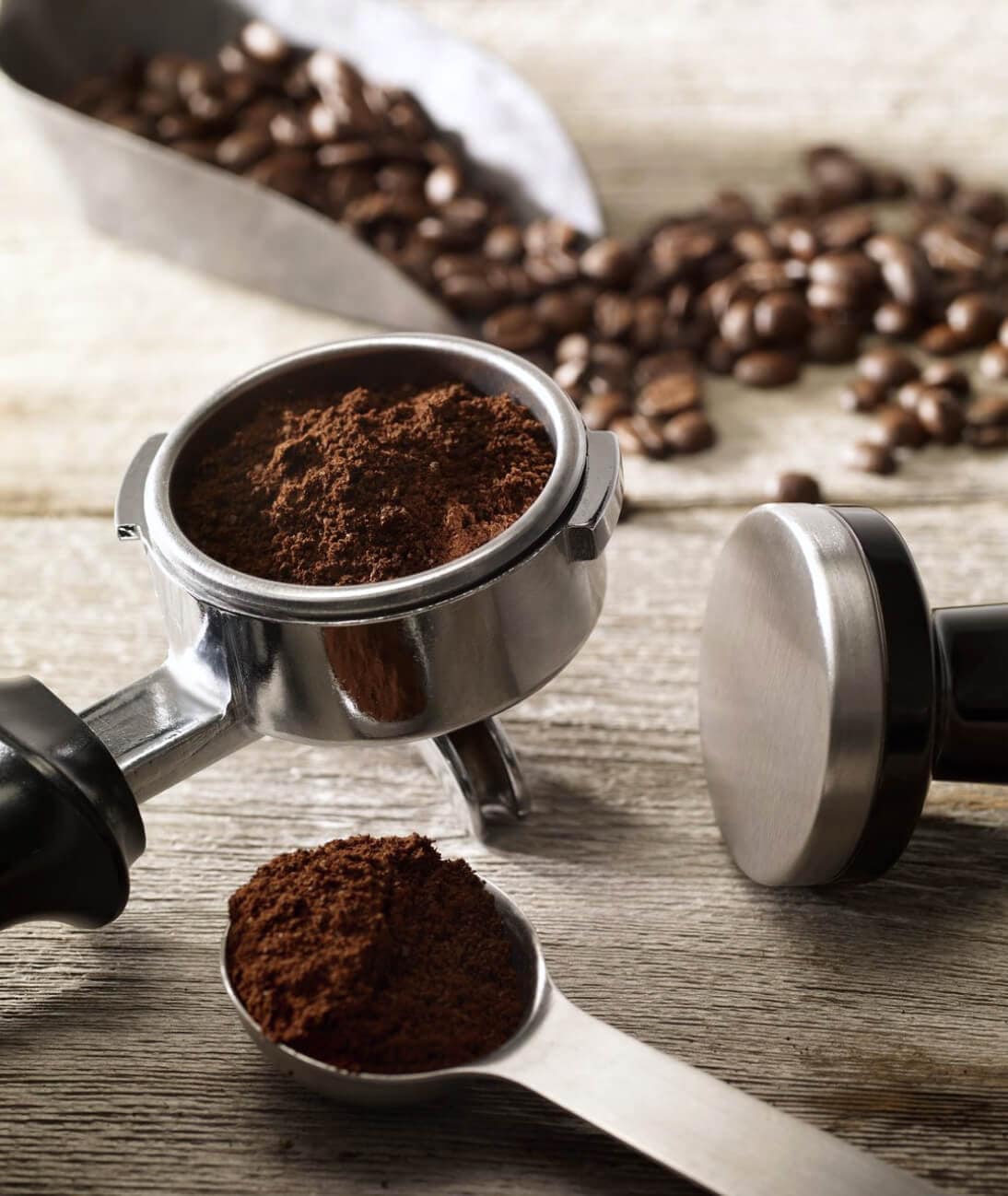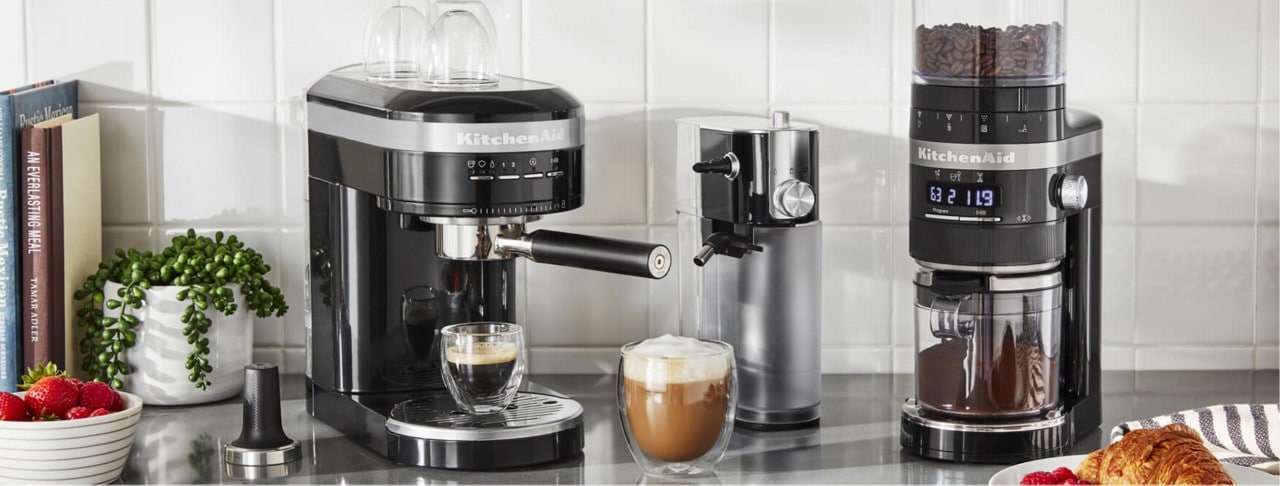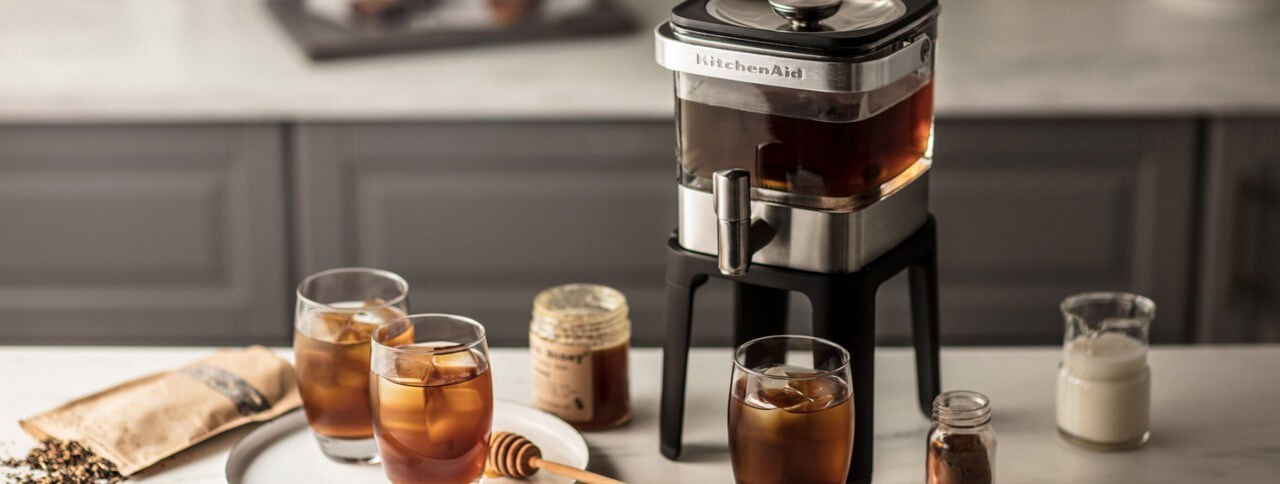
HOW TO MAKE THE BEST CUP OF COFFEE AT HOME
Great coffee is an essential part of the day for many of us but going to a coffee shop for some whipped coffee or other specialty drink isn’t always convenient. Luckily, brewing a perfect cup of coffee or trying your hand at different types of espresso drinks is something that anyone can do with a little knowledge and the right equipment.
Because coffee beans and water are the only two ingredients in the best home coffee, the art of brewing coffee is in the details. Keep reading to learn about the right beans, the right grind, the right water temperature and the right equipment. And let our guide help you understand the different brewing methods – drip, pour over, French press and cold brew – so you can discover how to create a perfect cup of barista-quality coffee for you and your guests in your very own kitchen coffee bar.
There are three important things to consider before you start brewing: whole beans vs. store ground, the most common types of beans and the importance of organic coffee beans.
1. Fresh beans are key
One of the best ways to ensure you’re getting the freshest beans is to grind them at home. The bean’s outer covering acts as a protective “armor,” sealing in the oils and aromas that give coffee its flavor. As soon as that covering is broken the coffee can start to lose those aromas. If you do decide to buy pre-ground coffee, buy it in a vacuum sealed bag and store it in an airtight container in a cool dry place, after the bag has been opened. Learn more about how to store ground coffee and whole beans.
In addition to providing the freshest coffee, grinding your own beans gives you control over taste and caffeination. Learn more about different types of coffee grinders or shop KitchenAid® coffee grinders to find one that fits your needs.
2. Arabica vs. Robusta
What is the best tasting coffee? The answer may depend on your palate. The two most common types of beans are Arabica and Robusta. Arabica beans are considered the “better bean” and produce a sweeter, softer taste while Robusta beans, which are easier to grow and are found in most supermarket coffees, have a stronger, harsher taste and contain twice as much caffeine as Arabica beans.
3. Organic makes a difference
Organic beans aren’t sprayed with pesticides and chemicals in the growing process but an organic label doesn’t always mean that the beans you’re buying are the best quality. Look for speciality-grade for the highest-quality coffee. This designation will assure you that your beans are grown in the most ideal conditions and harvested with care. Look for them at local roasters.
Naturally you want this ingredient to be of the highest quality as well so always use bottled or filtered water. The chlorine and other chemicals in regular tap water can produce unwanted notes in your coffee. And because the minerals in high-quality water are necessary for the best home brew coffee using distilled or softened water is not recommended and could also damage your coffee maker.
COFFEE TIP:
For clean, fresh filtered water straight from the fridge make sure you use a great filter and change it every six months. everydrop® ice and water filters are the only filters approved by KitchenAid.1
1. everydrop® products and the recommended brand's products are owned and distributed by Whirlpool Corporation
Water is the thing that extracts flavor out of your coffee beans, so making sure your water is the right temperature is essential for good results. Experts recommend using water between 195º F-205º F; water in this range will dissolve your grounds most effectively. Water that’s too cool will produce a weak cup of coffee and water that’s too hot will make coffee bitter.
Here’s what you’ll need:
Filters
Scale
COFFEE GRINDER
COFFEE MAKER
There are a number of different coffee maker styles and which one you choose really comes down to personal preference. You may want to invest in one or more of them depending on how much coffee you need to brew, the time you have to invest and the flavor you’re expecting to produce. This Coffee Maker Buying Guide helps you compare coffee makers and determine which one is best for your unique needs. Here’s a quick snapshot of the most popular options and their advantages.
Be sure to shop the KitchenAid® coffee collection and coffee accessories for more inspiration.

FOR THE PURIST
A pour over is considered by many to be the ideal way to brew a complex cup of coffee; you have total control over every element and can tweak or alter with a few adjustments in technique. Learn more about pour over vs. drip coffee brewing methods.
Here are step-by-step instructions for the different brewing methods we’ve discussed.
DRIP COFFEE
- Pour grounds into a filter-lined basket and place in the coffee maker – if grinding your own beans grind to the consistency of table salt.
- Swivel spout over center of grounds.
- Pour purified or filtered water in the back of the coffee maker and press “on.”
- When coffee is done brewing, turn the machine off to avoid burning your coffee. Serve and enjoy.
COFFEE TIP:
A general rule of thumb for coffee to water ratio is called the “Golden Ratio”– 1 to 2 tablespoons of coffee per 6 ounces of water. But keep in mind that coffee is personal so you may want to adjust according to taste.
POUR OVER COFFEE
Bring cold, filtered water to a boil in a kettle. A gooseneck style is ideal for pour overs.
If using whole beans, grind to the consistency of table salt.
Put a paper filter in the brewer, then rinse with hot water to remove filter residue and warm the brewer. Discard used water.
Place a level layer of grounds in the filter and pour water that has been heated to 195º F-205º F slowly and evenly over the grounds. Start in the center of the grounds and work your way out. Stop pouring before the coffee begins dripping into the brewer to allow the coffee to de-gas. This is known as the “bloom” pour.
Take the next 3-4 minutes to slowly pour the remaining water over the grounds. Remove the filter. Serve and enjoy.
FRENCH PRESS COFFEE
Bring filtered water to a boil in a kettle.
If using whole beans, grind to the consistency of coarse breadcrumbs. Add the grounds to the French Press.
Heat the water to 195º F-205º F and add it to the French press. Stir heated water into the grounds. It will take about 4 minutes to brew. Slowly plunge, separating grounds from the brewed coffee.
Serve and enjoy immediately. To avoid bitter coffee pour any leftovers into a carafe and enjoy later.
COLD BREW COFFEE
If using whole beans, grind to the consistency of coarse breadcrumbs.
Add filtered water and ground coffee to the cold brew maker.
Steep for 12-24 hours in your refrigerator.
Strain through a filter or cheesecloth into a clean container.
Add milk, ice and enjoy. Store extra cold brew in the refrigerator for up to two weeks.

BEST COFFEE RECIPE
A well-crafted cup of coffee is one of life’s simple, and some might even argue – essential – pleasures. The best coffee recipe for your tastes might require a little experimentation with roasts, water temperature, as well as the coffee maker itself. But don’t stop at that perfect cup of home brewed coffee. Take those newly acquired barista skills and apply them to a special latte, coffee frappe or decadent coffee dessert. There’s a world of possibility out there. Check out this recipe for Cold Brew Coffee Floats to get started.
Make the best cup of coffee at home with the KitchenAid® coffee collection
Make a delicious home-brewed cup of coffee with KitchenAid® appliances. From burr grinders and blade grinders to espresso machines and drip coffee makers, KitchenAid brand has the tools you need for making your favorite brew or experimenting with a new latte recipe.









